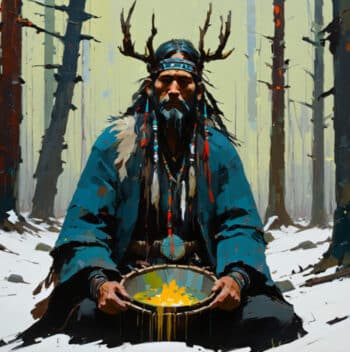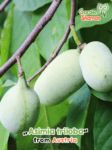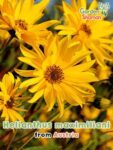- Shamanism in Europe
- Historical background
- Rituals in European shamanism
- Plants in shamanism
- Holidays
- Shamanism today
Shamanism in Europe has a long and fascinating history. Over the centuries, various European cultures and peoples have developed and practiced shamanic practices. In this blog article, we will take a look at the origins of shamanism in Europe and look at the various rituals, plants and festivals that play a role in European shamanism. We will also look at how shamanism is still practiced in Europe today and what meaning it has for people. So immerse yourself in the world of European shamanism and learn more about this fascinating spiritual tradition.
1. shamanism in Europe
European shamanism has a long and varied history. Shamanic rituals took place thousands of years ago, strengthening the connection between humans and nature. Such rituals are still practiced in Europe today, although they have evolved and changed over time. Plants play an important role in shamanism - whether as a remedy or to support spiritual experiences. Certain festivals are also closely linked to shamanism, such as the Celtic Samhain festival or the Germanic winter solstice. Nowadays, shamanism is experiencing a renaissance in Europe and is seen by many people as an alternative spiritual practice. Through the connection with nature, a deep understanding of the world around us is said to emerge and thus also a deeper understanding of ourselves.
2. historical background
There are numerous historical influences from different regions in European shamanism. The oldest traces date back to the Stone Age and can be traced back to cave paintings and finds of ritual objects. Over the centuries, various traditions have developed that have their roots in Europe. These include, for example, Celtic shamanism and Germanic shamanism. The Christianization of Europe has also left its mark by adopting and reinterpreting elements of shamanism. For example, sacred springs and places were transformed into Christian pilgrimage sites. Nowadays, European shamanism is experiencing a renaissance as people increasingly want to return to spiritual practices that are in harmony with nature and enable a deep connection to the universe.
3. rituals in European shamanism
Rituals play an important role in European shamanism. They are used to make contact with the spirits and the spiritual world and to ask for help and healing for the community or the individual. These rituals can vary greatly depending on the region and tradition. One example is the so-called "séances", in which the shaman is put into a trance in order to connect with the spirits. Or the setting up of stone circles to create a sacred space and focus the forces of nature. Plants are another important element in European shamanism. They are often used as medicine or as tools in rituals. For example, burning certain herbs such as sage or lavender can help to get rid of negative energies and purify the space. In addition to these special practices, there are also festivals in European shamanism that are linked to certain events, such as the solstice or equinox celebrations. Today, shamanism is still alive in Europe and is practiced by many people. There are even training courses to become a shaman or shamaness as well as seminars, workshops and spiritual journeys on offer. Conclusion: Rituals are an essential part of European shamanism and serve to establish a connection to the spiritual world. Plants and festivals are other important elements that play a role in the practice of shamanism. Despite its long history, shamanism is still alive today and is practiced by many people.
4. plants in shamanism
Plants play an important role in European shamanism. They are often used as remedies and also serve to make contact with the spirit of nature. There are certain plants that are particularly valued. For example, the fly agaric is considered an important companion on shamanic journeys. The herb mugwort has also found its place in shamanism and is often used in cleansing rituals. Another example is holly, which is considered sacred in many cultures and is often used for protection or blessing ceremonies. Plants are therefore not only a natural part of shamanism, but also a central aspect of spiritual work with the forces of nature.
5. holidays
Festival days play an important role in the European shamanic tradition. These are often linked to the seasons and the cycle of nature and mark important turning points in the life of a shaman. One of the best-known festivals is the winter solstice, also known as Yule. On this day, shamans celebrate the return of the light and the end of the dark season. Another important festival is Beltane, which is celebrated on April 30 or May 1 and marks the beginning of summer. It is a festival of fertility and growth, when shamans often perform ritual dances and collect herbs to use later for healing rituals. Other festivals in European shamanism are Samhain (the Celtic festival of the dead) and Lammas (the harvest festival). These festivals show how closely interwoven the European shamanic tradition is with nature and its cycles. Even today, these festivals are still celebrated by many people to strengthen their connection to nature and deepen their spiritual practices.
6 Shamanism today
Shamanism today is primarily about connecting with nature and one's inner self. Many people use this spiritual practice to find a balance to their hectic everyday lives and want to return to their roots. Tradition also plays an important role here, as shamanic rituals often have a long history and are deeply rooted in Europe's cultural heritage. However, modern elements also find their place in today's shamanism, such as the incorporation of new technologies or the adaptation of rituals to contemporary needs. The diversity of shamanism is also reflected in the different currents that exist - from Celtic to Nordic to Baltic shamanism, there is something for everyone. However, they all have one thing in common: they show us that we are part of a greater whole and that we can lead a more fulfilling life through mindfulness and respect for nature.
Note: The information in this article is for informational purposes only and is not intended to replace the advice of a physician or other healthcare professional. Always consult a doctor before using any new herbs or supplements. Furthermore, you should always check whether certain plants are permitted in your country before growing them.














